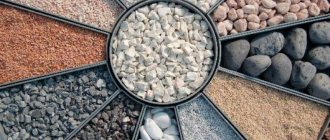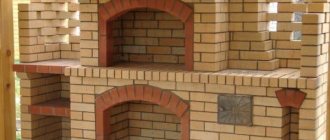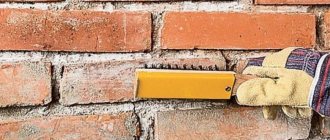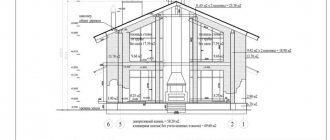Concrete brick is considered one of the most durable and reliable building materials. It has increased wear resistance and a long service life. The ease of its manufacture allows experienced builders to create concrete blocks at home. However, it is necessary to strictly observe the proportions to avoid the formation of cracks in the base of the concrete stone. It is also necessary to take into account the scope of application of various types of building materials in order to ensure reliability of the future project.
Composition and properties of concrete bricks
Such a product is the most durable and reliable building unit, since it is not affected by changes caused by climatic conditions. To produce concrete bricks, you need light or heavy fine-grained concrete with its constituent mineral fillers and binders (cement, gypsum). Under natural conditions or during heat treatment, it hardens. The distinctive characteristics of the stone are:
- universal size chart;
- wide selection of products;
- varied color palette;
- resistance to external factors;
- increased fire resistance.
Block composition
It is quite possible to call concrete brick a good environmentally friendly alternative to the usual clay material. It differs only in its increased strength and resistance to mechanical damage.
Solid and hollow brick.
The composition of this material is quite simple, because the basis for its production is concrete with mineral sealants and special binding components, in particular such as gypsum or cement. Hardening of concrete bricks occurs under normal conditions or during firing.
All the technical characteristics inherent in ordinary building bricks are also present in the concrete analogue, but only much better. Concrete brick has different thicknesses, so it can be single or thickened.
The following types of material are distinguished: solid concrete, hollow concrete, as well as with a smooth and embossed surface.
How is production carried out?
The formation process consists of hyper-compression, while the building stone goes through several stages of production. Cement, sand and aggregate are taken for production. Concrete brick goes through the following stages:
- preparation of a specialized mixture;
- dilution of the solution;
- forming the product under pressure;
- heat and wet treatment;
- packaging and transportation.
When composing the mixture, preference is given to white cement and Portland cement. The first provides attractiveness and reduces the risk of cracks forming, and the second allows other components of the block to set. Sand acts as a guarantor of the strength and reliability of bricks, but this is possible when using only high-quality raw materials. Otherwise, the recycled material may cause the opposite effect and lead to rapid crumbling of the building unit. The filler can be any material that can provide the necessary strength to the product.
To avoid brittleness of bricks, aggregate granules should not exceed 10 mm in diameter.
Forms for creating a concrete block
In factory manufacturing conditions, specialized techniques are used, but this does not prevent you from creating bricks at home. To do this, you will need a container in which the product will be formed. You need to select an iron sheet and cut it to the required size. The M150 prototype is most often chosen to save materials. 2-3 parts of a solid steel tube, which is slightly smaller than the thickness of the block, are welded to the bottom. Then the edges of the mold are welded along the outer seam to avoid the formation of seams inside the structure. The dimensions of concrete bricks directly depend on the chosen form, the production of which is carried out according to factory standards.
Main types of concrete blocks
In factories or at home, you can make two types of bricks:
- Full-bodied. It acts as a homogeneous block, which has high strength and is chosen when implementing heavy construction projects. Typically, it is used to erect load-bearing walls of high-rise residential complexes and lay strip foundations, which ensures their long-term strength.
- Hollow. Less durable, but has increased sound insulation, therefore it is used in the construction of residential buildings as an element of room partitions. It has good moisture resistance, which allows it to be used in humid climates.
Brick formwork is a type of permanent system
Without installing concrete formwork, it is impossible to pour the foundation for a construction project. Several types of structures are used. Brick formwork is a type of permanent system. The technology of monolithic reinforced concrete construction allows us to achieve strength, long service life and a presentable appearance.
Requirements for permanent formwork
The design is subject to certain operational standards:
- Use waterproof material and seal seams.
- Accurate calculation of structural strength to withstand pressure.
- Correct geometry of elements and high-quality masonry.
- Long service life.
Application of formwork
The brick base is technically suitable for industrial and residential buildings. The compressive strength value ranges from 150 to 200 kilograms per square centimeter.
A brick foundation will support a wall made of different materials and densities (kg/m3): natural wood - 600, foam concrete - 900, sand-lime brick - 2000.
The construction method allows you to build several types of foundations:
The construction of a brick foundation will be carried out by a team of several people; the use of special heavy equipment will not be required.
What material is used
The formwork is made from several types of bricks. The material has no technical contraindications. It is very difficult to determine which type is better. The high cost of materials and labor costs does not frighten builders. After all, the result is a durable and warm frame of the object.
Not every type of material is suitable for foundation construction. It is better to give preference to red brick rather than silicate brick. It's all about production technology. Sand-lime brick is produced by pressing from sand. Clay products are fired, so they are stronger and not afraid of moisture.
A competitor to previous materials is clinker brick. It is made from a special type of clay. Has high technical characteristics. The product is expensive, so it is mainly used for cladding.
Design and structural calculations
All work on the construction of the foundation is carried out in accordance with GOST requirements. The material used for the construction of formwork is provided depending on the load:
- horizontal (lateral solution pressure, wind load);
- vertical (weight of reinforcement mesh, concrete, formwork).
?
Based on the drawn design, it is easy to calculate the total mass of the structure. The following parameters are used for calculations:
- load from builders – 250 kilograms per square meter;
- concrete – 2500 kg/m2;
- fittings – 100 kg/m2.
Wind load values are taken from SNiP tables. Taking into account correction factors, lateral pressure is calculated. You should also take into account the mobility of the mixture, the temperature of the working solution, and the speed of filling the formwork.
Sequence and features of work execution
It is not difficult to erect permanent brick formwork; it is important to follow the masonry technology. Rubble masonry techniques are mainly used. After a certain distance, a brick is placed, which serves as an anchor. Usually the step is set to two elements.
After construction, the walls are thoroughly dried. Then pour the base inside.
A sand-cement mixture prepared in certain proportions is used as a working solution.
Before erecting the formwork for a brick foundation, preparatory work is carried out:
- A pit is dug under the future foundation. The lower platform is reinforced with sand and gravel. The height of the layer is made at least 0.3 meters.
- The prepared base is reinforced. I make the surface smooth and durable.
- Brick laying is carried out in compliance with technology.
- To reduce the pressure on the prepared base, the plane of the rows should be made parallel.
- The side faces of the future foundation form a system of perpendicular zones with longitudinal and transverse seams.
- To keep the walls strong, you cannot place bricks edge-on.
The technology allows the construction of multi-storey and industrial buildings.
The formwork can be made with double-sided brickwork. And also on one side, for the internal wall, slabs of increased rigidity and density are used.
The advantage of the technology is that simultaneously with the construction of the walls, the façade and interior finishing are carried out. There is no need to additionally cover the foundation.
How to pour concrete into formwork
The technology for performing the work takes into account air temperature, humidity, climatic precipitation, and soil properties. Based on the indicators, the brand of concrete solution is selected.
You can prepare the working mixture yourself using a concrete mixer or buy a ready-made one. You should choose concrete grade M300 and higher.
When pouring concrete into the formwork, a mixing patch is used. In this case, special equipment must drive very close to the construction site.
When using the manual method, buckets or other containers are used. Using a concrete mixer, a working solution is prepared. The main thing is to follow a few rules:
- Strictly adhere to the proportions indicated in the instructions.
- Use only clean equipment and supplies.
- Mix thoroughly.
?
To evenly distribute concrete in brick formwork, use a shovel or rule. A vibrator is used to compact the mixture. This allows you to get a high-quality foundation. Reinforcing bars can be used to compact concrete. They allow you to remove air from concrete.
The final stage is drying the brick and concrete structure.
Arrangement of blind area and plinth
As soon as the foundation is brought to the ground level, it is necessary to arrange the blind areas. This is a waterproof coating around the perimeter of a construction site. The system is sloped away from the building. The blind area protects the base from rain flows.
Work begins only after filling the cavity between the foundation pit and the brick foundation of the future object. Typically a sand and gravel mixture is used.
The basement part of the building is erected using red or sand-lime brick. But before this, a waterproofing threshold is performed. This will prevent moisture from entering from the base. The laying is done in one and a half (1.5) or two and a half (2.5) bricks.
Advantages and disadvantages of technology
The result of construction work is:
- Robust monolithic construction.
- The material has good heat-insulating properties.
- The use of brick eliminates the need for facing work.
- Construction technology helps to construct objects of various geometries and implement unusual architectural designs.
The disadvantage of such construction is the large financial investments and labor costs.
When choosing the type of future foundation, you need to take into account the properties of the soil.
Using permanent brick formwork
The technology of monolithic construction using brick formwork for pouring concrete has become relevant. Using the method allows you to speed up work and create a durable structure. The construction method is suitable for the construction of industrial and residential buildings.
Source: https://betonov.com/fundament/opalubka/opalubka-iz-kirpicha.html
What is the scope of application?
Building stone is a universal material, so there are no limits to its application. This is achieved thanks to the peculiarities of its manufacture and strength characteristics. Concrete bricks are used to:
- foundation finishing;
- laying out fences;
- external and internal facing works;
- internal partitions;
- basements;
- bearing structures.
The specificity of the masonry depends on the method of using the brick and usually does not present any serious difficulty. Concrete bricks adhere well to the mortar, which makes installation particularly easy.
Composition of Lego bricks, in proportions
The mixture includes available ingredients such as by-products of stone crushing - screenings of dolomite, marble, crushed stone, shell rock, sand, cement, water.
The quality of the resulting brick is directly affected by the particle size of the raw materials. The finer the better the quality.
The proportions in the mixture are as follows:
- fine-grained component from 85 to 92%;
- cement from 8 to 15%,
- pigment for coloring;
- water.
When preparing the mixture, it is necessary to take into account that the use of sand, as well as screenings of dolomite and crushed stone, although acceptable, is undesirable.
Since this will lead to the fact that the final product will have insufficient stability characteristics. It cannot be used for load-bearing structures.
The consumption of raw materials is as follows - to make 500 bricks or one cube, you will need 220 kg of binder (cement) and 1600 kg of fine fractions.
The composition of the initial mixture varies based on specified parameters, such as the scope of application, operating conditions, as well as the characteristics of the vibration presses used.
Lego bricks are made by pressing under high pressure. In fact, the mixture produces an artificial stone.
It is excellent for cladding buildings, laying out internal partitions and load-bearing walls.
Technological process
The technological process itself can be described as follows. After loading the ingredients, active mixing is carried out in the mixer, then the mixture is sent through the conveyor to the hopper.
Through a special dispenser, the steel matrix is filled; in the matrix, under the influence of vibration and pressure, the working mixture is evenly distributed. High pressure and vibration give the Lego brick its final shape.
The steaming chamber significantly speeds up the process of obtaining a quality product. The brick is processed with steam at a temperature of +70 degrees for at least 7-8 hours.
If the chamber is not included in the technological process, then the brick is aged on racks for 20-25 days, during which time the temperature in this place is maintained at a level not lower than +15 degrees.
Has the following main characteristics:
- strength 300 kg per sq. cm,
- density 1550 kg per cubic meter. m,
- frost resistance up to 150 cycles,
- not exceeding 6% moisture absorption level.
Advantages of Lego bricks
Lego bricks also have a number of advantages over other types of bricks.
The existing installation grooves significantly speed up and strengthen the masonry, its strength is 1.7 times higher than the masonry of standard bricks.
Technological holes are used, for example, for electrical wiring or other communications.
Elimination of firing from the manufacturing process significantly reduces costs. While winning in price, it also offers a wide range of colors and textures.
This is an almost ideal option for the construction of toilets, showers, gazebos and all kinds of fencing.
Lego brick, masonry
The possibility of its use by non-professionals also looks advantageous. In fact, the level is used only when laying out the first layer.
Further, the existing formation grooves and tenons will significantly increase the speed of the process. At the same time, the preparation of a special solution is not required; when laying, a special glue is used, which can be applied with a regular brush.
The glue further reduces costs, because to assemble 1 cube you will need only 25 kg of tile adhesive (for exterior use). The resulting wall is not only aesthetically pleasing, but also does not require additional plastering.
To increase the seismic resistance of a structure, bricklaying is used with thin wire ligation on each layer, as well as inserting reinforcement and pouring concrete mixture into the holes of the bricks.
Buildings built from Lego are distinguished by: efficiency, reduced thermal conductivity, high wear resistance and frost resistance, increased resistance to moisture, and low load on the foundation.
Mini Lego brick production
To organize the independent production of Lego bricks, any small room with a ceiling height of at least 3.5 meters is suitable.
Good ventilation, water supply, sewerage and connection to 380 V electrical networks will be required. To ensure quality, sudden temperature fluctuations are unacceptable. It is maintained indoors at a level above 5 degrees.
To organize production, you will need to purchase a hopper, a batcher, a crusher, a vibrating sieve, a mixer, a hyperpress, a matrix and a steaming chamber.
Most of this equipment contains a mini installation. It only lacks a steaming chamber, which in principle you can do without.
When selecting equipment, the following must be considered. The quality of Lego bricks is greatly influenced by the working pressure of the press; it must be at least 130 kg/sq.cm. The press must provide a pressure of 30 tons.
When choosing a matrix, wall thickness and strength play a special role. If the metal thickness is less than 20 mm, then a few days of work, and the abrasive process will completely destroy the matrix.
It is very important that the press is equipped with sensors that monitor the thickness of the brick and the depth of filling of raw materials. It is problematic to visually determine the difference in the height of bricks.
Of course, organizing independent Lego production will require the entrepreneur to solve a number of complex problems; obtaining a high-quality product is impossible without proven technology and high quality raw materials.
Nevertheless, it is possible to create a profitable mini-workshop. Purchasing the necessary equipment will require an investment that will be recouped very quickly.










